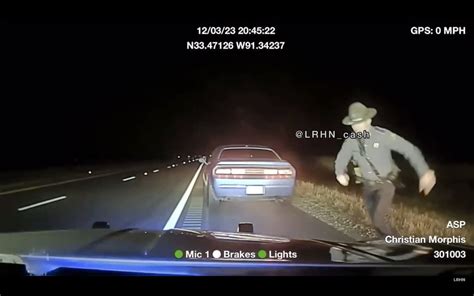
A Dodge Challenger driver fleeing a Mississippi State Trooper crashed at an estimated 160 mph, leaving the vehicle a mangled wreck and resulting in serious injuries. The high-speed chase and subsequent crash occurred early Saturday morning in Lauderdale County.
High-Speed Chase Ends in Devastating Crash
A driver in a Dodge Challenger, attempting to evade a Mississippi State Trooper, wrecked his vehicle at a staggering speed of approximately 160 mph in Lauderdale County early Saturday. The crash left the Challenger heavily damaged and the driver with serious injuries. According to reports, the incident unfolded as a trooper attempted to initiate a traffic stop, prompting the Challenger driver to accelerate and flee.
The Mississippi Highway Patrol confirmed the incident, stating that the pursuit began after the trooper observed the Challenger speeding. The driver, whose identity has not been officially released, immediately increased his speed in an attempt to outrun the patrol car. The trooper pursued the Challenger, but the chase was short-lived as the driver lost control of the vehicle at an extremely high speed.
“The driver was traveling at such a high rate of speed that he lost control and crashed,” stated a spokesperson for the Mississippi Highway Patrol. “The vehicle sustained significant damage, and the driver was transported to a local hospital with serious injuries.”
The exact circumstances leading to the traffic stop are still under investigation. However, preliminary reports suggest that the Challenger was exceeding the posted speed limit by a considerable margin. The speed limit on the stretch of highway where the chase occurred is believed to be 70 mph, making the Challenger driver’s speed more than double the legal limit.
Images of the crash site reveal the extent of the damage to the Challenger. The vehicle is almost unrecognizable, with twisted metal and debris scattered across the scene. The force of the impact was so great that parts of the car were ejected several yards away from the main wreckage.
Details of the Pursuit and Crash
The incident began around 2:00 a.m. on Saturday when a Mississippi State Trooper noticed a Dodge Challenger speeding on Interstate 20 in Lauderdale County. The trooper attempted to pull the vehicle over, but the driver refused to stop and instead accelerated, initiating a high-speed pursuit.
According to police reports, the Challenger reached speeds of approximately 160 mph during the chase. The trooper continued to pursue the vehicle, but due to the extreme speed and the inherent dangers of a high-speed pursuit, the trooper maintained a safe distance.
“Our troopers are trained to assess the risks involved in any pursuit,” explained a Mississippi Highway Patrol supervisor. “In this case, the trooper recognized the danger posed by the excessive speed and adjusted his tactics accordingly. The primary goal is always to ensure the safety of the public and our officers.”
The pursuit continued for several miles before the Challenger driver lost control of the vehicle. The car veered off the road and crashed into a nearby embankment. The impact was severe, causing extensive damage to the Challenger.
Emergency responders were immediately dispatched to the scene. Upon arrival, they found the driver trapped inside the wreckage. Firefighters had to use specialized equipment to extricate the driver from the car. The driver was then transported by ambulance to a local hospital for treatment of serious injuries.
The Mississippi Highway Patrol is conducting a thorough investigation into the incident. The investigation will focus on determining the exact cause of the crash and whether any other factors contributed to the accident. Investigators will also review the trooper’s actions during the pursuit to ensure that all protocols and procedures were followed.
Legal and Safety Implications
The incident raises several legal and safety concerns. First and foremost, the driver of the Challenger faces multiple charges, including reckless driving, speeding, and fleeing from law enforcement. These charges could result in significant fines, jail time, and the suspension or revocation of the driver’s license.
“Fleeing from law enforcement is a serious offense that carries significant penalties,” said a local attorney familiar with traffic laws. “In addition to the charges related to the initial traffic violation, the driver could face additional charges for endangering the lives of others and causing property damage.”
The incident also highlights the dangers of high-speed pursuits. While law enforcement officers have a duty to apprehend suspected criminals, they must also weigh the risks involved in pursuing a vehicle at high speeds. High-speed pursuits can endanger the lives of the officers, the suspects, and innocent bystanders.
“High-speed pursuits are inherently dangerous,” said a former law enforcement officer who now works as a safety consultant. “They should only be initiated when there is a clear and immediate threat to public safety. Otherwise, the risks outweigh the potential benefits.”
Many law enforcement agencies have implemented strict policies regarding high-speed pursuits. These policies typically require officers to consider factors such as the severity of the crime, the risk to public safety, and the road and weather conditions before initiating a pursuit. Officers are also trained to use alternative tactics, such as surveillance and roadblocks, to apprehend suspects without engaging in high-speed chases.
The Dodge Challenger and High-Speed Driving
The Dodge Challenger, known for its powerful engine and aggressive styling, has sometimes been associated with incidents of reckless driving and speeding. The car’s high performance capabilities can be tempting for some drivers, leading to dangerous and illegal behavior.
“The Dodge Challenger is a high-performance vehicle that is capable of reaching very high speeds,” said an automotive expert. “While it is perfectly safe when driven responsibly, it can be a dangerous weapon in the hands of an inexperienced or reckless driver.”
The Challenger is equipped with a variety of safety features, including anti-lock brakes, stability control, and airbags. However, these features are not a substitute for responsible driving. Drivers must always obey traffic laws, drive at safe speeds, and avoid reckless behavior.
Several organizations are working to promote safe driving practices and reduce the number of accidents caused by speeding and reckless driving. These organizations offer driver education courses, public awareness campaigns, and other programs designed to help drivers make better choices behind the wheel.
“Safe driving is everyone’s responsibility,” said a spokesperson for a national traffic safety organization. “We all need to do our part to prevent accidents and save lives. That means obeying traffic laws, driving defensively, and never driving under the influence of drugs or alcohol.”
Community Reaction
The incident has sparked a range of reactions from the local community. Some residents expressed concern about the dangers of high-speed pursuits and the potential for innocent bystanders to be injured. Others expressed anger at the driver of the Challenger for endangering the lives of others and wasting valuable resources.
“I’m just glad that no one else was hurt,” said a resident who lives near the scene of the crash. “It’s scary to think that someone was driving that fast on our roads. It could have easily been a lot worse.”
Local officials have also weighed in on the incident. They have praised the Mississippi Highway Patrol for their efforts to apprehend the suspect and have reiterated their commitment to ensuring the safety of the community.
“We take traffic safety very seriously,” said a local elected official. “We will continue to work with law enforcement to ensure that our roads are safe for everyone.”
The Mississippi Highway Patrol is urging anyone with information about the incident to contact them. They are also reminding drivers to obey traffic laws and drive responsibly.
Investigation and Further Details
As the investigation continues, authorities are piecing together the events leading up to the crash. Investigators are examining the vehicle’s black box, which may provide additional information about the speed and other factors that contributed to the accident. They are also interviewing witnesses and reviewing any available video footage.
The Mississippi Highway Patrol is expected to release a full report on the incident once the investigation is complete. The report will include detailed information about the cause of the crash, the actions of the driver and the trooper, and any recommendations for preventing similar incidents in the future.
In the meantime, the driver of the Challenger remains hospitalized. His condition is currently unknown. Once he is released from the hospital, he will be formally charged with multiple offenses.
The incident serves as a stark reminder of the dangers of speeding and reckless driving. It also highlights the importance of responsible law enforcement practices and the need for ongoing efforts to promote traffic safety.
The Wider Context of High-Speed Chases
The Dodge Challenger incident is not an isolated one. High-speed chases are a recurring problem in many communities across the country. They pose a significant risk to public safety and often result in serious injuries or fatalities.
According to data from the National Highway Traffic Safety Administration (NHTSA), thousands of people are injured or killed in police pursuits each year. Many of these victims are innocent bystanders who are caught in the path of the chase.
Several factors contribute to the problem of high-speed chases. These include the increasing availability of high-performance vehicles, the prevalence of reckless driving behavior, and the challenges faced by law enforcement officers in apprehending suspected criminals.
Addressing the problem requires a multifaceted approach. This includes stricter enforcement of traffic laws, improved driver education programs, and the development of alternative tactics for apprehending suspects without engaging in high-speed chases.
Law enforcement agencies are also exploring the use of technology to reduce the risks associated with high-speed pursuits. This includes the use of GPS tracking devices, remote vehicle immobilization systems, and drones.
“Technology can play a key role in reducing the need for high-speed pursuits,” said a technology expert who specializes in law enforcement solutions. “By using these tools, officers can apprehend suspects more safely and effectively.”
The Dodge Challenger incident serves as a wake-up call for the need to address the problem of high-speed chases. By working together, law enforcement, policymakers, and the public can create safer communities for everyone.
The Aftermath and Ongoing Concerns
Following the crash, the focus shifts to the recovery of the injured driver and the ongoing investigation. The community grapples with the implications of such a high-speed incident occurring within their locale, raising questions about road safety, law enforcement protocols, and individual responsibility.
The Mississippi Highway Patrol is reviewing its policies and procedures related to high-speed pursuits to determine if any adjustments are necessary. This review will include an examination of the decision-making process that led to the pursuit in this particular case, as well as a broader assessment of the risks and benefits of high-speed chases in general.
“We are committed to ensuring that our officers have the training and resources they need to make sound decisions in high-pressure situations,” said a spokesperson for the Mississippi Highway Patrol. “We will carefully review this incident to identify any areas where we can improve our policies and procedures.”
In addition to the internal review, the incident may also prompt a broader discussion about traffic safety and law enforcement practices at the state and national levels. Policymakers may consider legislation to strengthen traffic laws, increase penalties for reckless driving, or restrict the circumstances under which high-speed pursuits can be initiated.
“This incident should serve as a catalyst for change,” said a local elected official. “We need to take a hard look at our traffic safety laws and law enforcement practices to ensure that we are doing everything we can to prevent these types of tragedies from happening in the future.”
The Dodge Challenger incident is a complex and multifaceted event with far-reaching implications. It highlights the dangers of speeding and reckless driving, the risks associated with high-speed pursuits, and the importance of responsible law enforcement practices. It also underscores the need for ongoing efforts to promote traffic safety and create safer communities for everyone.
The conversation extends beyond the immediate aftermath, encompassing discussions on driver education, vehicle safety technology, and the psychological factors that contribute to reckless driving behavior. Experts emphasize the need for a comprehensive approach that addresses all aspects of the problem, from prevention to enforcement to rehabilitation.
Continued Monitoring and Future Prevention
Law enforcement agencies are continuously monitoring trends in traffic accidents and using data-driven insights to develop targeted strategies for reducing crashes and fatalities. This includes identifying high-risk areas, deploying resources to those areas, and conducting targeted enforcement campaigns.
“We are constantly analyzing data to identify patterns and trends in traffic accidents,” said a traffic safety expert. “This allows us to develop targeted strategies for addressing the most pressing problems.”
Technology also plays a crucial role in preventing future incidents. Advanced driver assistance systems (ADAS), such as automatic emergency braking and lane departure warning, can help drivers avoid accidents. These systems are becoming increasingly common in new vehicles and have the potential to significantly reduce the number of crashes.
“ADAS technology has the potential to save lives,” said an automotive engineer. “These systems can help drivers stay alert, avoid distractions, and react quickly to changing conditions.”
In addition to technology, education and awareness campaigns are essential for promoting safe driving practices. These campaigns can help drivers understand the risks of speeding, reckless driving, and distracted driving. They can also provide tips for staying safe on the road.
“Education is key to preventing accidents,” said a traffic safety advocate. “We need to educate drivers about the dangers of risky behavior and empower them to make responsible choices behind the wheel.”
The Dodge Challenger incident serves as a reminder that traffic safety is an ongoing challenge that requires the sustained efforts of law enforcement, policymakers, and the public. By working together, we can create safer roads and prevent future tragedies.
FAQ Section:
1. What exactly happened in the Dodge Challenger incident?
- A Dodge Challenger driver, while attempting to evade a Mississippi State Trooper during a traffic stop, crashed at an estimated speed of 160 mph in Lauderdale County. The driver sustained serious injuries, and the vehicle was heavily damaged. The pursuit began after the trooper observed the Challenger speeding on Interstate 20. The driver refused to stop and accelerated, initiating the high-speed chase.
2. What charges could the driver of the Dodge Challenger face?
- The driver could face multiple charges, including reckless driving, speeding, and fleeing from law enforcement. These charges could result in significant fines, jail time, and the suspension or revocation of the driver’s license. As one local attorney stated, “Fleeing from law enforcement is a serious offense that carries significant penalties. In addition to the charges related to the initial traffic violation, the driver could face additional charges for endangering the lives of others and causing property damage.”
3. Why did the Mississippi State Trooper initiate the traffic stop?
- The trooper initiated the traffic stop after observing the Dodge Challenger speeding on Interstate 20. Preliminary reports suggest that the Challenger was exceeding the posted speed limit by a considerable margin, believed to be more than double the legal limit of 70 mph on that stretch of highway.
4. What are the safety implications of high-speed pursuits like this one?
- High-speed pursuits are inherently dangerous and pose a significant risk to public safety. They can endanger the lives of the officers involved, the suspects being pursued, and innocent bystanders. Many law enforcement agencies have strict policies regarding high-speed pursuits to minimize these risks. A former law enforcement officer noted, “High-speed pursuits are inherently dangerous. They should only be initiated when there is a clear and immediate threat to public safety. Otherwise, the risks outweigh the potential benefits.”
5. What is the current status of the investigation into the Dodge Challenger crash?
- The Mississippi Highway Patrol is conducting a thorough investigation into the incident. Investigators are examining the vehicle’s black box, interviewing witnesses, and reviewing any available video footage. The investigation aims to determine the exact cause of the crash and whether any other factors contributed to the accident. The driver of the Challenger remains hospitalized, and formal charges will be filed upon release. The Mississippi Highway Patrol is expected to release a full report on the incident once the investigation is complete.
6. What role did the Dodge Challenger’s performance capabilities play in the incident?
The Dodge Challenger, known for its powerful engine and aggressive styling, is capable of reaching high speeds, which may have contributed to the severity of the incident. Its high performance can be tempting for some drivers, leading to dangerous and illegal behavior. An automotive expert explained, “The Dodge Challenger is a high-performance vehicle that is capable of reaching very high speeds. While it is perfectly safe when driven responsibly, it can be a dangerous weapon in the hands of an inexperienced or reckless driver.”
7. What measures are being taken to prevent similar high-speed incidents in the future?
Law enforcement agencies are continuously monitoring traffic accident trends, using data to develop targeted strategies, and deploying resources to high-risk areas. Technology such as advanced driver assistance systems (ADAS) and public awareness campaigns are also crucial for promoting safe driving practices. A traffic safety advocate emphasized, “Education is key to preventing accidents. We need to educate drivers about the dangers of risky behavior and empower them to make responsible choices behind the wheel.”
8. What is the community’s reaction to this incident?
The community has expressed concern about the dangers of high-speed pursuits and the potential for innocent bystanders to be injured. Some residents have voiced anger at the driver for endangering lives and wasting resources. Local officials have praised the Mississippi Highway Patrol and reiterated their commitment to community safety.
9. What are some alternative tactics that law enforcement can use instead of high-speed pursuits?
Law enforcement agencies can use several alternative tactics to apprehend suspects without engaging in high-speed chases. These include surveillance, roadblocks, GPS tracking devices, remote vehicle immobilization systems, and drones. Technology expert mentioned, “Technology can play a key role in reducing the need for high-speed pursuits. By using these tools, officers can apprehend suspects more safely and effectively.”
10. What role does driver education play in preventing incidents like this?
Driver education is essential for promoting safe driving practices and reducing the number of accidents caused by speeding and reckless driving. Driver education courses and public awareness campaigns can help drivers make better choices behind the wheel and understand the risks of risky behavior. As stated by a spokesperson for a national traffic safety organization, “Safe driving is everyone’s responsibility. We all need to do our part to prevent accidents and save lives. That means obeying traffic laws, driving defensively, and never driving under the influence of drugs or alcohol.”









